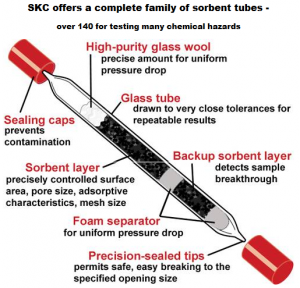Air Sampling
This article serves two purposes.
First, it will provide descriptions of the more straightforward air sampling concepts and procedures.
Second, if an air sampling method involves more details such that it needs its own article, this page will act as a hub for those additional methods.
One thing to remember: A large amount of this information came from, and can be found in, the OSHA Technical Manual (OTM) Section II Chapter 1. Certain sections of the OTM were updated in at least 2014, including this chapter on air sampling.
Arrangements of Sampling Train
Charcoal Tubes
From https://www.skcinc.com/catalog/product_info.php?products_id=567
- Just before sampling, use a scorer/breaker tool to uniformly break the ends of the sorbent tube to a 2 mm diameter or half the diameter of the tube body.
- Keep the tube in a vertical position during sampling to prevent the possibility of channeling that can lead to under-sampling.
- The arrow on the tube indicates air flow direction and should point to the tube holder and pump. If no arrow is present, the smallest section should be near the tube holder.
Impinger
Video demonstrating setup and usage.
Isocyanates
Enter Isocyanate sampling methods and info about solvent stability.
Mold Sampling
Method
| Time | 2 Hours |
| Media | MCEF in 37.5mm cassette |
| Flow Rate | 2 L/min |
| Tubing | Use a short length of tubing — just long enough to be able to flex and point down. |
- The intake on the cassette always needs to be facing down so that other, heavier particles will not land on the filter.
- One pump is used outside to get the CFU count for the facility's surrounding environment.
- One or more pumps are placed inside around the areas of concern.
Notes
- When results come back with a significantly higher fungus count (CFU/m³) for the inside as opposed to the outside count, a letter is sent to the company contact detailing the findings, the hazards, and remediation. (A template is saved in Documents.)
- The CSHO compiles a draft letter, which is printed out and submitted in the report under the IB tab.
- The digital original is sent to your supervisor so that it can be passed on to an admin for revising the date and for review by the Program Manager.
Total Spore Counts vs. Colony Forming Units (CFU)
From "Smells moldy in here" - EMSL.com
Air sampling methods can be divided into two different categories: methods generating “total spore counts,” typically reported as counts per cubic meter (m3) and methods that determine “culturable fungi,” typically reported as colony forming units (CFU) per cubic meter. Total spores counts are an amalgamate of both living and nonliving spores. These methods do not allow for the discrimination between living or dead spores. Culturable fungi results, tabulate only living fungal particles, which can include hyphal fragments as well as spores.
Sampling for total spore counts can be carried out using specially-greased slides and a Burkard or Allergenco sampler. Initial costs for these devices are high but subsequent purchases of greased slides are relatively inexpensive. The principal behind each of these devices is the same; air is vacuumed through and condensed onto the greased slide. Particles in the air are forced onto the grease, become embedded, and stick to its surface.
A more common approach would be to use your own vacuum pump with specially-designed, single-use spore-trap cassettes. Some of the popular cassettes on the market include the Cyclex-d, Air-O-Cell, Microcell5, and the Laro100. Particles in the air are trapped in the cassette either on a proprietary adhesive or, as in the case of the Laro100, a 0.8-micron (mm) filter. The cassettes are opened, prepped and examined under a microscope in a laboratory by properly trained analysts who determine the total spore count. Depending upon your specific complaint or scenario, it may not be important to know the viability of a spore, since dead spores are also potentially allergenic or toxigenic to susceptible individuals.
Respirable Dust – Cyclone
| Media | PVC | ||
|---|---|---|---|
- Media: PVC 1.7 L/min
- Using the Cyclone eliminates all particles but respirable particles.
- Using anything BUT the Cyclone will give you Total Dust.
SafeLog
- Use Form OSHA-93 Direct Reading Report.
- Carbon Monoxide (CO) has an IDLH of 1200 ppm.
- Nitrogen dioxide (NO2) has an IDLH of 20 ppm.
- Make sure to set sampling parameters as follows:
| CAL LVL | HI LVL | STEL | TWA | Comments | |
| CO | 50 | 200 | Your discretion | 50 | |
| NO₂ | 25 ? | 5 | 1 | Your choice |
† NIOSH recommended values
‡ OSHA PELs
─────
Screening
- When screening for substances with a direct read device (such as the Drager or a SafeLog), results are recorded on an OSHA-93 "Direct Reading Report" form, which details each location screened and results.
- Additionally, an OSHA-98 "Screening Report" form should be completed for all screened substances.
